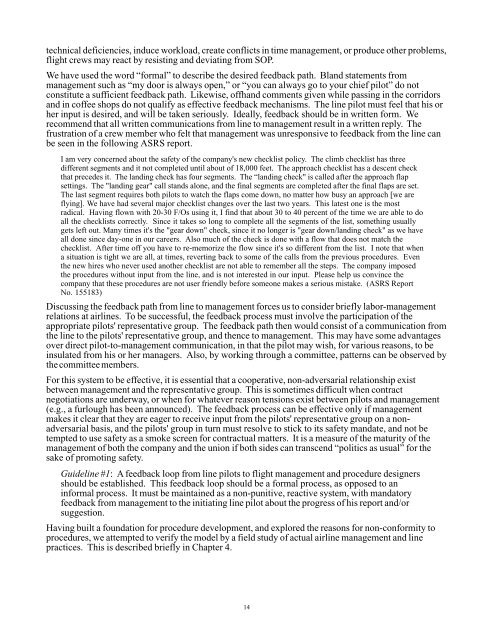On the Design of Flight-Deck Procedures - Intelligent Systems ...
On the Design of Flight-Deck Procedures - Intelligent Systems ...
On the Design of Flight-Deck Procedures - Intelligent Systems ...
You also want an ePaper? Increase the reach of your titles
YUMPU automatically turns print PDFs into web optimized ePapers that Google loves.
technical deficiencies, induce workload, create conflicts in time management, or produce o<strong>the</strong>r problems,flight crews may react by resisting and deviating from SOP.We have used <strong>the</strong> word “formal” to describe <strong>the</strong> desired feedback path. Bland statements frommanagement such as “my door is always open,” or “you can always go to your chief pilot” do notconstitute a sufficient feedback path. Likewise, <strong>of</strong>fhand comments given while passing in <strong>the</strong> corridorsand in c<strong>of</strong>fee shops do not qualify as effective feedback mechanisms. The line pilot must feel that his orher input is desired, and will be taken seriously. Ideally, feedback should be in written form. Werecommend that all written communications from line to management result in a written reply. Thefrustration <strong>of</strong> a crew member who felt that management was unresponsive to feedback from <strong>the</strong> line canbe seen in <strong>the</strong> following ASRS report.I am very concerned about <strong>the</strong> safety <strong>of</strong> <strong>the</strong> company's new checklist policy. The climb checklist has threedifferent segments and it not completed until about <strong>of</strong> 18,000 feet. The approach checklist has a descent checkthat precedes it. The landing check has four segments. The “landing check" is called after <strong>the</strong> approach flapsettings. The "landing gear" call stands alone, and <strong>the</strong> final segments are completed after <strong>the</strong> final flaps are set.The last segment requires both pilots to watch <strong>the</strong> flaps come down, no matter how busy an approach [we areflying]. We have had several major checklist changes over <strong>the</strong> last two years. This latest one is <strong>the</strong> mostradical. Having flown with 20-30 F/Os using it, I find that about 30 to 40 percent <strong>of</strong> <strong>the</strong> time we are able to doall <strong>the</strong> checklists correctly. Since it takes so long to complete all <strong>the</strong> segments <strong>of</strong> <strong>the</strong> list, something usuallygets left out. Many times it's <strong>the</strong> "gear down" check, since it no longer is "gear down/landing check" as we haveall done since day-one in our careers. Also much <strong>of</strong> <strong>the</strong> check is done with a flow that does not match <strong>the</strong>checklist. After time <strong>of</strong>f you have to re-memorize <strong>the</strong> flow since it's so different from <strong>the</strong> list. I note that whena situation is tight we are all, at times, reverting back to some <strong>of</strong> <strong>the</strong> calls from <strong>the</strong> previous procedures. Even<strong>the</strong> new hires who never used ano<strong>the</strong>r checklist are not able to remember all <strong>the</strong> steps. The company imposed<strong>the</strong> procedures without input from <strong>the</strong> line, and is not interested in our input. Please help us convince <strong>the</strong>company that <strong>the</strong>se procedures are not user friendly before someone makes a serious mistake. (ASRS ReportNo. 155183)Discussing <strong>the</strong> feedback path from line to management forces us to consider briefly labor-managementrelations at airlines. To be successful, <strong>the</strong> feedback process must involve <strong>the</strong> participation <strong>of</strong> <strong>the</strong>appropriate pilots' representative group. The feedback path <strong>the</strong>n would consist <strong>of</strong> a communication from<strong>the</strong> line to <strong>the</strong> pilots' representative group, and <strong>the</strong>nce to management. This may have some advantagesover direct pilot-to-management communication, in that <strong>the</strong> pilot may wish, for various reasons, to beinsulated from his or her managers. Also, by working through a committee, patterns can be observed by<strong>the</strong> committee members.For this system to be effective, it is essential that a cooperative, non-adversarial relationship existbetween management and <strong>the</strong> representative group. This is sometimes difficult when contractnegotiations are underway, or when for whatever reason tensions exist between pilots and management(e.g., a furlough has been announced). The feedback process can be effective only if managementmakes it clear that <strong>the</strong>y are eager to receive input from <strong>the</strong> pilots' representative group on a nonadversarialbasis, and <strong>the</strong> pilots' group in turn must resolve to stick to its safety mandate, and not betempted to use safety as a smoke screen for contractual matters. It is a measure <strong>of</strong> <strong>the</strong> maturity <strong>of</strong> <strong>the</strong>management <strong>of</strong> both <strong>the</strong> company and <strong>the</strong> union if both sides can transcend “politics as usual” for <strong>the</strong>sake <strong>of</strong> promoting safety.Guideline #1: A feedback loop from line pilots to flight management and procedure designersshould be established. This feedback loop should be a formal process, as opposed to aninformal process. It must be maintained as a non-punitive, reactive system, with mandatoryfeedback from management to <strong>the</strong> initiating line pilot about <strong>the</strong> progress <strong>of</strong> his report and/orsuggestion.Having built a foundation for procedure development, and explored <strong>the</strong> reasons for non-conformity toprocedures, we attempted to verify <strong>the</strong> model by a field study <strong>of</strong> actual airline management and linepractices. This is described briefly in Chapter 4.14
















